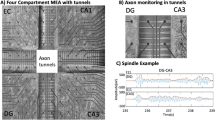Conclusions
-
1.
Neurons of slices of the septum are equally highly reactive to ACh, NA, and 5-HT introduced into the reaction medium (86–88% of the neurons change their level or the nature of their spontaneous activity).
-
2.
A predominance of activation effects are characteristic of NA and ACh (strong and developing rapidly in the first case, weaker and gradual in the second). 5-HT suppresses and increases the activity of the neurons to an equal degree.
-
3.
Only ACh causes the appearance, intensification, or increase in the frequency of the rhythmic volley activity. In certain cells the volleys evoked by ACh are removed in a medium with a high Mg2+ content, while in others they are preserved.
-
4.
Cells of the septum with regulatory activity of the pacemaker type, on the whole, are less reactive to the action of substances and Mg2+ than neurons with nonregulatory activity. In cases of reactivity of these cells to the indicated influences, an increase or decrease in the average frequency occurs without any disturbance of the regularity of the spike discharges. It is suggested that mediator substances act on part of the cells of the septum as modulators of the endogenous pacemaker mechanism.
Similar content being viewed by others
Literature cited
S. D. Zhadina and O. S. Vinogradova, “Influence of acetylcholine and glutamate on septal neuronsin vitro,” Zh. Vyssh. Nervn. Deyat.,30, No. 2, 392 (1980).
J. F. De France, R. A. McGrea, and H. Yoshihara, “Effects of certain indoleamines in the hippocampal-septal circuit,” Expt. Neurol.,48, No. 2, 352 (1975).
J. F. De France, H. Yoshihara, R. A. McGrea, and S. T. Kitai, “Pharmacology of the inhibition in the lateral septal region,” Exp. Neurol.,48, No. 3, 502 (1975).
F. G. Graeff, S. Quntero, and J. A. Gray, “Median raphe stimulation, hippocampal theta rhythm, and threat-induced behavioral inhibition,” Physiol. Behav.,25, No. 2, 253 (1980).
W. Harkmark, S. I. Mellgren, and B. Srebro, “Acetylcholinesterase histochemistry of the septal region in rat and human: Distribution of enzyme activity,” Brain Res.,95, No. 1–2, 281 (1975).
B. E. Jones and R. Y. Moore, “Ascending projections of the locus coeruleus in the rat. II. Autoradiographic study,” Brain Res.,127, No. 1, 23 (1977).
K. J. Kellar, P. A. Brown, J. Madrid, M. Bernstein, J. Vernikos-Daniellis, and W. R. Mehler, “Origins of serotonin innervation of forebrain structures,” Expt. Neurol., 56, No. 1, 52 (1977).
P. R. Lewis and C. C. D. Shute, “The cholinergic limbic system: projections of hippocampal formation, medial cortex, nuclei of the ascending cholinergic reticular system, and the subfornical organ and supra-optic crest,” Brain,90, No. 3, 526 (1967).
O. Lindvall and U. Steveni, “Dopamine and noradrenaline neurons projecting to the septal area in the rat,” Cell. Tiss. Res.,190, No. 3, 383 (1978).
M. Palkovits, “Neuronal pathways and neurotransmitters in septum pellucidum of rat (short review),” Endocrinol. Expt.,10, No. 3, 225 (1976).
P. Poulain, “Excitation des neurons de la region preoptico-septal par application iontophoretique d'acetylcholine,” C. R. Acad. Sci.,279, 1773 (1974).
M. Segal, “Responses of septal nuclei neurons to microiontophoretically administered putative neurotransmitters,” Life Sci.,14, No. 7, 1345 (1974).
B. Srebro, S. I. Mellgren, and W. Harkmark, Ed. J. F. De France, “Acetylcholinesterase histochemistry of the septal region in the rat,” in: The Septal Nuclei, Plenum Press, New York-London (1976), p. 65.
C. H. Vanderwolf, “Neocortical and hippocampal activation in relation to behaviour: Effects of atropine, eserine, phenothiazine and amphetamine,” J. Comp. Physiol. Psychol.,88, No. 1, 300 (1975).
O. S. Vinogradova, E. S. Brazhnik, A. M. Karanov, and S. D. Zhadina, “Analysis of neuronal activity in rabbit's septum with various conditions of deafferentation,” Brain Res.,187, No. 2, 354 (1980).
Author information
Authors and Affiliations
Additional information
Translated from Zhurnal Vysshei Nervnoi Deyatel'nosti imeni I, P. Pavlova, Vol. 32, No. 2, pp. 319–326, March–April, 1983.
Rights and permissions
About this article
Cite this article
Zhadina, S.D., Vinogradova, O.S. Effects of acetylcholine, norepinephrine, and serotonin on neurons of the septumin vitro . Neurosci Behav Physiol 13, 405–411 (1983). https://doi.org/10.1007/BF01182682
Received:
Issue Date:
DOI: https://doi.org/10.1007/BF01182682




